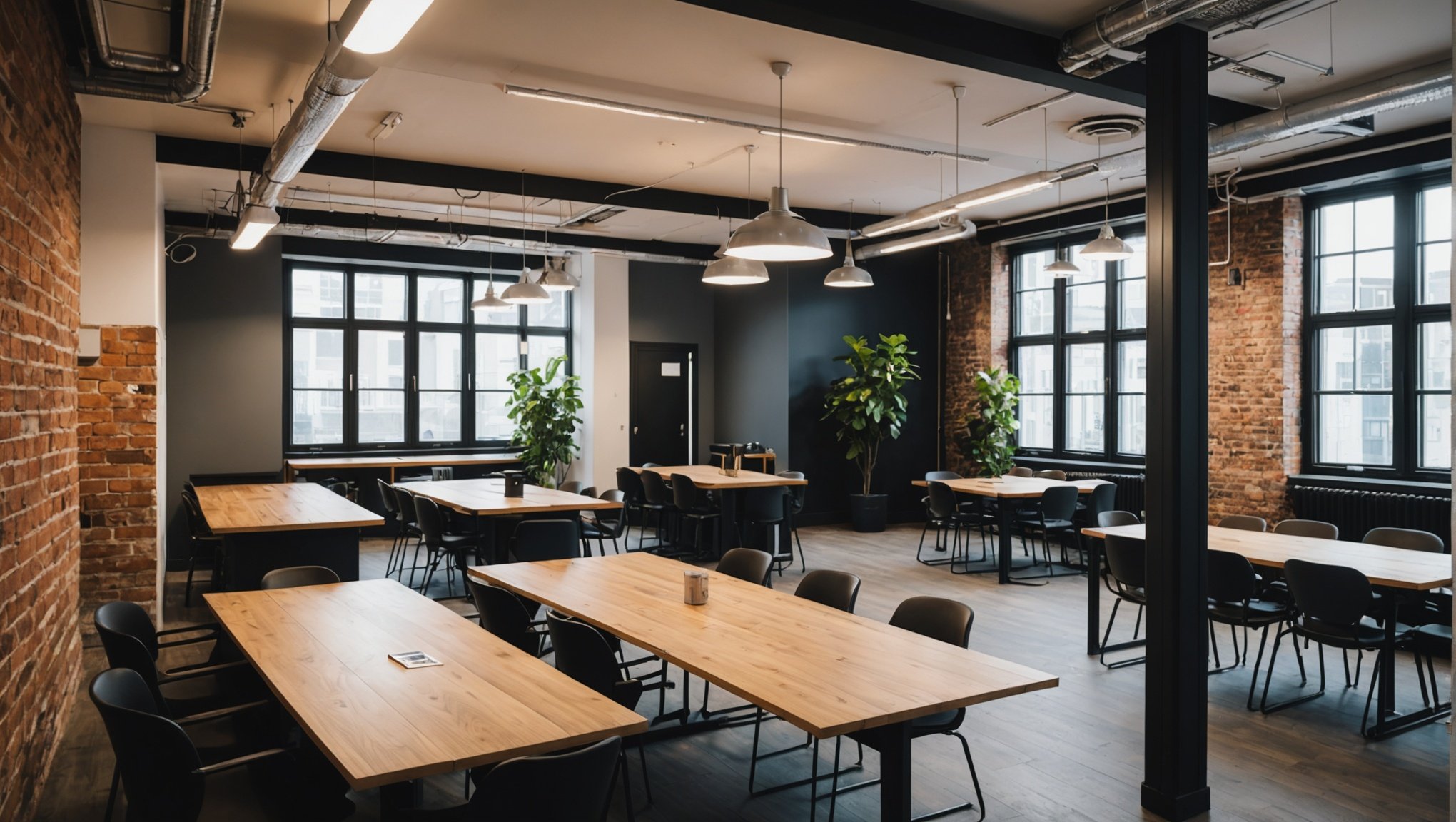Your Ultimate Guide to Establishing a UK Coworking Space Compliant with Fire Safety Standards
Understanding the Importance of Fire Safety in Coworking Spaces
When it comes to setting up a coworking space in the UK, one of the most critical aspects to consider is fire safety. The consequences of neglecting fire safety measures can be devastating, not only in terms of human life but also for the continuity and reputation of your business. The Regulatory Reform (Fire Safety) Order 2005 (FSO2005) is the cornerstone of fire safety legislation in the UK, and compliance with this order is mandatory for all premises, including coworking spaces.
Legal Requirements for Fire Safety
The FSO2005 places a significant burden on the “Responsible Person” for the building, who is typically the owner, occupier, or manager of the premises. This person is tasked with ensuring that all necessary fire safety measures are in place and that regular fire risk assessments are conducted.
Also read : Mastering the UK”s Environmental Assessment for Your Sustainable Hotel Project: A Step-by-Step Guide
Key Responsibilities of the Responsible Person
- Conducting Fire Risk Assessments: A thorough fire risk assessment must be carried out to identify potential fire hazards and outline strategies to mitigate them. This assessment should evaluate all areas of the coworking space and consider how the users are actually using the building.
- Implementing Preventive Measures: Based on the risk assessment, the Responsible Person must implement measures to reduce or eliminate fire risks. This includes ensuring that there are adequate means of escape, fire alarms, fire extinguishers, and clear evacuation routes.
- Maintaining Records: All fire risk assessments and the measures implemented must be documented and kept up-to-date. This includes records of safety drills, training sessions, and maintenance of fire safety equipment.
Creating a Comprehensive Fire Safety Plan
A well-structured fire safety plan is essential for ensuring the safety of all occupants in your coworking space.
Steps to Develop a Fire Safety Plan
- Conduct a Thorough Fire Risk Assessment: This forms the foundation of your fire safety plan. Identify potential hazards, such as electrical equipment, kitchen areas, and any other sources of ignition.
- Establish Emergency Procedures: Develop detailed evacuation routes and assembly points. Ensure protocols are in place for alerting emergency services and assisting individuals with disabilities.
- Train Staff and Coworkers: Regular training sessions and drills are crucial to ensure everyone understands their role during an emergency. This enhances preparedness and builds confidence in handling potential fire incidents.
- Review and Update the Plan: The fire safety plan should be reviewed regularly to ensure it remains relevant and effective. Incorporate feedback from training sessions to continuously improve the plan.
Compliance with Building Regulations
In addition to the FSO2005, coworking spaces must also comply with the Building Regulations, particularly those related to fire safety.
Topic to read : Launching Your Urban Gardening Venture in the UK: A Guide to Navigating Local Agricultural Regulations
Key Building Regulations
- Requirement B1: Means of early warning of fire and adequate means of escape from the building, including emergency lighting and fire exit signage.
- Requirement B2: Control of internally fire spread (linings). Wall linings must resist the spread of flames and give off only reasonable levels of heat if on fire.
- Requirement B3: Control of internal fire spread (structure). Fire and smoke must be prevented from spreading to concealed spaces in the building’s structure through fire stopping and fire cavity barriers.
- Requirement B4: External fire spread. The external walls and roof must resist the spread of fire to other buildings. This includes restrictions on the use of combustible materials in external walls of buildings over 18 meters high.
Fire Safety Equipment and Systems
Ensuring that your coworking space is equipped with the right fire safety equipment and systems is vital.
Essential Fire Safety Equipment
- Fire Alarms: A reliable fire alarm system is crucial for early detection of fires. Ensure it is regularly tested and maintained.
- Fire Extinguishers: Provide fire extinguishers that are easily accessible and suitable for the types of fires that could occur in your space. Regular inspections and maintenance are necessary.
- Fire Doors: Fire doors play a critical role in preventing the spread of fire. Ensure they are properly installed, maintained, and that all occupants understand their importance.
- Emergency Lighting: Clear evacuation routes must be illuminated with emergency lighting to ensure safe escape during a fire.
Regular Maintenance and Inspections
Regular maintenance and inspections are key to ensuring that your fire safety measures remain effective.
Maintenance Checklist
- Fire Alarm Systems: Regularly test and maintain fire alarm systems to ensure they are functioning correctly.
- Fire Extinguishers: Inspect fire extinguishers monthly and have them serviced annually.
- Fire Doors: Check fire doors regularly to ensure they are in good condition and functioning properly.
- Emergency Lighting: Test emergency lighting systems regularly to ensure they are working correctly.
- Evacuation Routes: Ensure all evacuation routes are clear and unobstructed.
Training and Drills
Training and drills are essential components of a robust fire safety plan.
Training Staff and Coworkers
- Regular Training Sessions: Conduct regular training sessions to ensure all staff and coworkers understand the fire safety procedures.
- Fire Drills: Conduct regular fire drills to practice evacuation procedures and ensure everyone knows their role in an emergency.
Funding and Support for Fire Safety Measures
For buildings that require significant fire safety upgrades, especially those related to cladding and external wall systems, there are funding schemes available.
Cladding Safety Scheme
The Cladding Safety Scheme (CSS) provides funding for works required to address life safety fire risks associated with cladding on residential buildings over 11 meters high. To be eligible, a Fire Risk Appraisal of External Wall construction (FRAEW) must be conducted, and the works must follow the recommendations based on the PAS 9980:2022 methodology.
Penalties for Non-Compliance
Non-compliance with fire safety regulations can result in severe penalties, including fines and even imprisonment.
Potential Penalties
- Fines: Minor offences can result in fines up to £5,000, while major offences can have unlimited fines.
- Imprisonment: Serious cases can result in a prison sentence of up to two years.
Establishing a coworking space that is compliant with fire safety standards is not just a legal requirement but a moral obligation to ensure the safety and well-being of all occupants. By understanding the legal requirements, creating a comprehensive fire safety plan, ensuring compliance with building regulations, maintaining the right equipment and systems, and conducting regular training and drills, you can make your coworking space a safe and secure environment.
Practical Insights and Actionable Advice
- Engage a Fire Safety Expert: If you are unsure about any aspect of fire safety, consider hiring a professional to conduct a fire risk assessment and provide guidance on compliance.
- Involve Your Community: Make sure all staff and coworkers are involved in the fire safety plan and understand their roles in case of an emergency.
- Stay Updated: Keep abreast of any changes in fire safety regulations and ensure your fire safety plan is reviewed and updated regularly.
By following these guidelines and taking fire safety seriously, you can ensure that your coworking space is not only compliant with the law but also a safe and welcoming environment for everyone.
Table: Comparison of Key Fire Safety Regulations and Requirements
| Regulation/Requirement | Description | Relevant Legislation/Document |
|---|---|---|
| Requirement B1 | Means of early warning of fire and adequate means of escape | Building Regulations, Approved Document B |
| Requirement B2 | Control of internally fire spread (linings) | Building Regulations, Approved Document B |
| Requirement B3 | Control of internal fire spread (structure) | Building Regulations, Approved Document B |
| Requirement B4 | External fire spread | Building Regulations, Approved Document B |
| FSO2005 | Fire risk assessments and general fire precautions | Regulatory Reform (Fire Safety) Order 2005 |
| Cladding Safety Scheme | Funding for addressing life safety fire risks associated with cladding | Cladding Safety Scheme overview |
| Fire Alarm Systems | Regular testing and maintenance of fire alarm systems | FSO2005, Building Regulations |
| Fire Extinguishers | Regular inspections and maintenance of fire extinguishers | FSO2005, Building Regulations |
| Fire Doors | Proper installation, maintenance, and use of fire doors | FSO2005, Building Regulations |
| Emergency Lighting | Regular testing of emergency lighting systems | FSO2005, Building Regulations |
Detailed Bullet Point List: Steps to Ensure Compliance with Fire Safety Regulations
- Conduct a Fire Risk Assessment:
- Identify potential fire hazards.
- Evaluate the risk of fire in all areas of the coworking space.
- Consider how the users are actually using the building.
- Implement Preventive Measures:
- Ensure adequate means of escape.
- Install fire alarms and ensure they are regularly tested.
- Provide fire extinguishers and ensure they are regularly inspected.
- Ensure clear evacuation routes and emergency lighting.
- Appoint a Responsible Person:
- Ensure the Responsible Person understands their duties.
- Ensure the Responsible Person conducts regular fire risk assessments.
- Maintain Records:
- Keep records of fire risk assessments.
- Keep records of safety drills and training sessions.
- Keep records of maintenance of fire safety equipment.
- Train Staff and Coworkers:
- Conduct regular training sessions on fire safety procedures.
- Conduct regular fire drills to practice evacuation procedures.
- Review and Update the Fire Safety Plan:
- Review the fire safety plan regularly.
- Update the plan based on feedback from training sessions and any changes in the use of the building.
- Ensure Compliance with Building Regulations:
- Ensure compliance with Requirement B1, B2, B3, and B4 of the Building Regulations.
- Ensure that external walls and roofs resist the spread of fire to other buildings.
- Regular Maintenance and Inspections:
- Regularly test and maintain fire alarm systems.
- Regularly inspect and maintain fire extinguishers.
- Regularly check fire doors to ensure they are in good condition.
- Regularly test emergency lighting systems.
By following these steps and staying informed about the latest regulations and best practices, you can ensure your coworking space is a safe and compliant environment for everyone.











